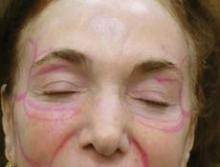LAS VEGAS – When treating tear trough deformities with hyaluronic acid fillers, Dr. Suzan Obagi makes it a point to have a set of sharp 30-gauge needles handy.
"There’s nothing worse than trying to do a treatment in the periorbital region, and then have your needles dull," she said during a demonstration on dermal fillers at the annual meeting of the American Academy of Cosmetic Surgery. "This can cause discomfort for the patient and probably more bruising. In a single session I may go through four or five needles. You’re better off having a sharp needle handy."
Dr. Obagi, who directs the University of Pittsburgh Medical Center's Cosmetic Surgery and Skin Health Center, likes to have an assistant on hand during periorbital injections of hyaluronic acid fillers, "so if you need to finish one side, the assistant can hold very gentle pressure on the treated area to minimize swelling and bruising," she said. "What you don’t want to do is push too hard. You’re in an area where you can easily move this filler to different regions. It should always be very light pressure on the area. I always tell patients not to rub or massage for 24 hours after the injection."
Some clinicians will treat the tear trough deformity without treating the rest of the orbital rim, she continued. "If patients have volume loss, it’s not just going to be the tear trough; it’s going to continue out to the sides of the orbit rim, especially in older patients," she said. "So it’s important to build up that area as well."
Dr. Obagi, who is also the immediate past vice president of the American Board of Cosmetic Surgery, prefers to use hyaluronic acid fillers that are smaller in particle size such as Medicis’ Restylane for tear trough deformities, adding lidocaine plus epinephrine prior to injection. "I use 0.3 mL 1% lidocaine with epinephrine and 0.2 mL sodium bicarbonate, and I use a Luer lock adapter to mix them together," she said. "I’m going to be working in an area where I want no bruising; in order to do that I need the epinephrine in there."
Dr. Obagi said that she had no relevant financial conflicts to disclose.


